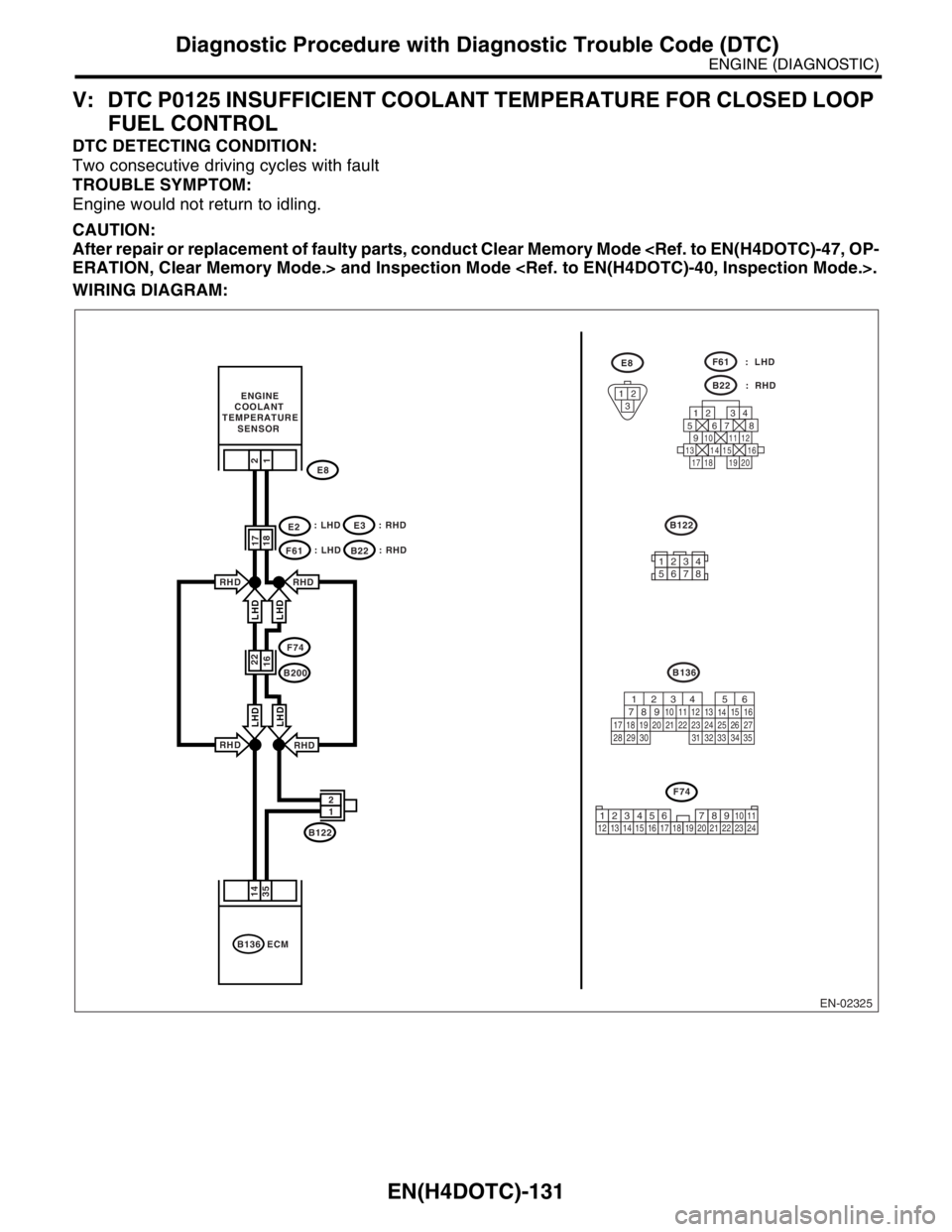2004 SUBARU FORESTER coolant temperature
[x] Cancel search: coolant temperaturePage 1764 of 2870

EN(H4DOTC)-131
ENGINE (DIAGNOSTIC)
Diagnostic Procedure with Diagnostic Trouble Code (DTC)
V: DTC P0125 INSUFFICIENT COOLANT TEMPERATURE FOR CLOSED LOOP
FUEL CONTROL
DTC DETECTING CONDITION:
Two consecutive driving cycles with fault
TROUBLE SYMPTOM:
Engine would not return to idling.
CAUTION:
After repair or replacement of faulty parts, conduct Clear Memory Mode
WIRING DIAGRAM:
EN-02325
B122
B136 ECM
35 14
E8 ENGINE
COOLANT
TEMPERATURE
SENSOR2
1
1 2
17
18
22
16F74
B200
LHD
LHD
RHD
RHD
LHD LHD
RHD
RHD
E8
12
3
B136
125678
131415169101112
34
17181920
B122B22 : RHD
F61 : LHD
F61
E2
: LHD
B22: RHD
F74
34
12 8910 11
12 13 14 15 16 17 18 19 20 21 22 23 2456 7
56
782 1
94 310
24 22 23 2511 12 13
1415
26 27
2816
17 18 19 20 21
33 34 29
32 30
31 35
12345678
: LHDE3: RHD
Page 1765 of 2870

EN(H4DOTC)-132
ENGINE (DIAGNOSTIC)
Diagnostic Procedure with Diagnostic Trouble Code (DTC)
W: DTC P0129 BAROMETRIC PRESSURE TOO LOW
DTC DETECTING CONDITION:
Two consecutive driving cycles with fault
CAUTION:
After repair or replacement of faulty parts, conduct Clear Memory Mode
Step Check Yes No
1 CHECK ANY OTHER DTC ON DISPLAY.Is any other DTC displayed? Inspect the rele-
vant DTC using
“List of Diagnostic
Trouble Code
(DTC)”.
List of Diagnostic
Trouble Code
(DTC).>
N
OTE:
In this case, it is
not necessary to
inspect DTC
P0125.Go to step 2.
2 CHECK ENGINE COOLING SYSTEM.
N
OTE:
Check the following items:
Thermostat open stuck
Coolant level
Coolant freeze
Tire diameterIs there a fault in engine cool-
ing system?Replace the ther-
mostat.
Thermostat.>Replace the
engine coolant
temperature sen-
sor.
Engine Coolant
Temperature Sen-
sor.>
Step Check Yes No
1 CHECK ANY OTHER DTC ON DISPLAY.Is any other DTC displayed? Inspect the rele-
vant DTC using
“List of Diagnostic
Trouble Code
(DTC)”.
List of Diagnostic
Trouble Code
(DTC).>
N
OTE:
It is not necessary
to inspect DTC
P0129.Replace the ECM.
Engine Control
Module (ECM).>
NOTE:
Atmospheric pres-
sure sensor is built
in ECM.
Page 1773 of 2870

EN(H4DOTC)-140
ENGINE (DIAGNOSTIC)
Diagnostic Procedure with Diagnostic Trouble Code (DTC)
Step Check Yes No
1 CHECK ANY OTHER DTC ON DISPLAY.Is any other DTC displayed? Inspect the rele-
vant DTC using
“List of Diagnostic
Trouble Code
(DTC)”.
List of Diagnostic
Trouble Code
(DTC).>Go to step 2.
2 CHECK FRONT (A/F) OXYGEN SENSOR DA-
TA.
1) Start the engine.
2) While observing the Subaru Select Monitor
or OBD-II general scan tool screen, warm-up
the engine until coolant temperature is above
70°C (158°F).
If the engine is already warmed-up, operate at
idle speed for at least 1 minute.
3) Read the data of front oxygen (A/F) sensor
signal using Subaru Select Monitor or OBD-II
general scan tool.
N
OTE:
Subaru Select Monitor
For detailed operation procedure, refer to the
“READ CURRENT DATA FOR ENGINE”.
OBD-II general scan tool
For detailed operation procedures, refer to the
OBD-II General Scan Tool Instruction Manual.Is the measured value 0.85 —
1.15 (in idling)?Go to step 3.Go to step 4.
3 CHECK REAR OXYGEN SENSOR SIGNAL.
1) Race the engine at speeds from idling to
5,000 rpm for a total of 5 cycles.
N
OTE:
To increase the engine speed to 5,000 rpm,
slowly depress accelerator pedal, taking ap-
prox. 5 seconds, and quickly release accelera-
tor pedal to decrease engine speed.
2) Operate the LED operation mode for
engine.
N
OTE:
Subaru Select Monitor
For detailed operation procedure, refer to the
“LED OPERATION MODE FOR ENGINE”.
2 Rich
Signal} blink?Repair the poor
contact in front
oxygen (A/F) sen-
sor and rear oxy-
gen sensor
connector.Check the rear
oxygen sensor cir-
cuit.
Rear Oxygen Sen-
sor.>
4 CHECK EXHAUST SYSTEM.
Check the exhaust system parts.
NOTE:
Check the following items.
Loose installation of portions
Damage (crack, hole etc.) of parts
Looseness of front oxygen (A/F) sensor
Looseness and ill fitting of parts between
front oxygen (A/F) sensor and rear oxygen
sensorIs there a fault in exhaust sys-
tem?Repair or replace
the faulty par ts.Replace the front
oxygen (A/F) sen-
sor.
Front Oxygen (A/
F) Sensor.>
Page 1775 of 2870

EN(H4DOTC)-142
ENGINE (DIAGNOSTIC)
Diagnostic Procedure with Diagnostic Trouble Code (DTC)
Step Check Yes No
1 CHECK ANY OTHER DTC ON DISPLAY.Is any other DTC displayed? Inspect the DTC
using “List of Diag-
nostic Trouble
Code (DTC)”.
List of Diagnostic
Trouble Code
(DTC).>Go to step 2.
2 CHECK REAR OXYGEN SENSOR DATA.
1) Warm-up the engine until engine coolant
temperature is above 70°C (158°F), and keep
the engine speed at 2,000 rpm to 3,000 rpm for
two minutes.
2) Read the data of rear oxygen (A/F) sensor
signal using Subaru Select Monitor or OBD-II
general scan tool.
N
OTE:
Subaru Select Monitor
For detailed operation procedure, refer to
“READ CURRENT DATA SHOWN ON DIS-
PLAY FOR ENGINE”.
OBD-II general scan tool
For detailed operation procedures, refer to the
OBD-II General Scan Tool Operation Manual.Does the value fluctuate? Go to step 6.Go to step 3.
3 CHECK REAR OXYGEN SENSOR DATA.
Read the data of rear oxygen (A/F) sensor sig-
nal using Subaru Select Monitor or OBD-II
general scan tool.Is the voltage 0.2 — 0.4 V? Go to step 4.Replace the rear
oxygen sensor.
Rear Oxygen Sen-
sor.>
4 CHECK HARNESS BETWEEN ECM AND
REAR OXYGEN SENSOR CONNECTOR.
1) Turn the ignition switch to OFF.
2) Disconnect the connector from ECM and
rear oxygen sensor.
3) Measure the resistance in harness
between ECM and rear oxygen sensor con-
nector.
Connector & terminal
(B137) No. 25 — (T6) No. 4:Is the resistance more than 3
Ω?Repair battery
short circuit in har-
ness between
ECM and rear oxy-
gen sensor con-
nector.Go to step 5.
5 CHECK HARNESS BETWEEN REAR OXY-
GEN SENSOR and ECM CONNECTOR.
1) Turn the ignition switch to OFF.
2) Disconnect the connector from rear oxygen
sensor.
3) Turn the ignition switch to ON.
4) Measure the voltage between rear oxygen
sensor harness connector and engine ground
or chassis ground.
Connector & terminal
(T6) No. 4 (+) — Engine ground (
−):Is the voltage more than 0.2 V? Replace the rear
oxygen sensor.
Rear Oxygen Sen-
sor.>Repair the har-
ness and connec-
tor.
N
OTE:
In this case repair
the following:
Open circuit in
harness between
rear oxygen sen-
sor and ECM con-
nector
Poor contact in
rear oxygen sen-
sor connector
Poor contact in
ECM connector.
Page 1778 of 2870

EN(H4DOTC)-145
ENGINE (DIAGNOSTIC)
Diagnostic Procedure with Diagnostic Trouble Code (DTC)
Step Check Yes No
1 CHECK ANY OTHER DTC ON DISPLAY.Is any other DTC displayed? Inspect the DTC
using “List of Diag-
nostic Trouble
Code (DTC)”.
List of Diagnostic
Trouble Code
(DTC).>Go to step 2.
2 CHECK REAR OXYGEN SENSOR DATA.
1) Warm-up the engine until engine coolant
temperature is above 70°C (158°F), and keep
the engine speed at 2,000 rpm to 3,000 rpm for
two minutes.
2) Read the data of rear oxygen (A/F) sensor
signal using Subaru Select Monitor or OBD-II
general scan tool.
N
OTE:
Subaru Select Monitor
For detailed operation procedure, refer to
“READ CURRENT DATA SHOWN ON DIS-
PLAY FOR ENGINE”.
OBD-II general scan tool
For detailed operation procedures, refer to the
OBD-II General Scan Tool Operation Manual.Does the value fluctuate? Go to step 6.Go to step 3.
3 CHECK REAR OXYGEN SENSOR DATA.
Read the data of rear oxygen (A/F) sensor sig-
nal using Subaru Select Monitor or OBD-II
general scan tool.Is the voltage 0.2 — 0.4 V? Go to step 4.Replace the rear
oxygen sensor.
Rear Oxygen Sen-
sor.>
4 CHECK HARNESS BETWEEN ECM AND
REAR OXYGEN SENSOR CONNECTOR.
1) Turn the ignition switch to OFF.
2) Disconnect the connector from ECM and
rear oxygen sensor.
3) Measure the resistance in harness
between ECM and rear oxygen sensor con-
nector.
Connector & terminal
(B137) No. 25 — (T6) No. 4:Is the resistance more than 3
Ω?Repair battery
short circuit in har-
ness between
ECM and rear oxy-
gen sensor con-
nector.Go to step 5.
5 CHECK HARNESS BETWEEN REAR OXY-
GEN SENSOR and ECM CONNECTOR.
1) Turn the ignition switch to OFF.
2) Disconnect the connector from rear oxygen
sensor.
3) Turn the ignition switch to ON.
4) Measure the voltage between rear oxygen
sensor harness connector and engine ground
or chassis ground.
Connector & terminal
(T6) No. 4 (+) — Engine ground (
−):Is the voltage more than 0.2 V? Replace the rear
oxygen sensor.
Rear Oxygen Sen-
sor.>Repair the har-
ness and connec-
tor.
N
OTE:
In this case repair
the following:
Open circuit in
harness between
rear oxygen sen-
sor and ECM con-
nector
Poor contact in
rear oxygen sen-
sor connector
Poor contact in
ECM connector
Page 1783 of 2870

EN(H4DOTC)-150
ENGINE (DIAGNOSTIC)
Diagnostic Procedure with Diagnostic Trouble Code (DTC)
4 CHECK FUEL PRESSURE.
After connecting the pressure regulator vac-
uum hose, measure fuel pressure.
Warning:
Release fuel pressure before removing the
fuel pressure gauge.
N
OTE:
If fuel pressure does not increase, squeeze
fuel return hose 2 to 3 times, then measure
fuel pressure again.
If out of specification as measured at this
step, check or replace pressure regulator and
pressure regulator vacuum hose.Is measured value 206 — 235
kPa (2.1 — 2.4 kg/cm
2, 30 —
34 psi)?Go to step 5.Repair the follow-
ing items.
Fuel pressure is
too high:
Faulty pres-
sure regulator
Clogged fuel
return line or
bent hose
Fuel pressure is
too low:
Faulty pres-
sure regulator
Improper fuel
pump discharge
Clogged fuel
supply line
5 CHECK ENGINE COOLANT TEMPERATURE
SENSOR.
1) Start the engine and warm-up completely.
2) Read the data of engine coolant tempera-
ture sensor signal using Subaru Select Monitor
or the OBD-II general scan tool.
NOTE:
Subaru Select Monitor
For detailed operation procedure, refer to
“READ CURRENT DATA SHOWN ON DIS-
PLAY FOR ENGINE”.
OBD-II general scan tool
For detailed operation procedures, refer to the
OBD-II General Scan Tool Operation Manual.Is engine coolant temperature
more than 60°C (140°F)?Go to step 6.Replace the
engine coolant
temperature sen-
sor.
Engine Coolant
Temperature Sen-
sor.>
6 CHECK MASS AIR FLOW AND INTAKE AIR
TEMPERATURE SENSOR.
1) Start and warm-up the engine until engine
coolant temperature is greater than 60°C
(140°F).
2) Place the shift lever in neutral position.
3) Turn the A/C switch to OFF.
4) Turn all accessory switches to OFF.
5) Read the data of mass air flow and intake
air temperature sensor signal using Subaru
Select Monitor or the OBD-II general scan tool.
N
OTE:
Subaru Select Monitor
For detailed operation procedure, refer to
“READ CURRENT DATA SHOWN ON DIS-
PLAY FOR ENGINE”.
OBD-II general scan tool
For detailed operation procedures, refer to the
OBD-II General Scan Tool Operation Manual.Is the measured value within
the following?
Ignition ON: 73.3 — 106.6 kPa
(550 — 800 mmHg, 21.65 —
31.50 inHg)
Idling: 24.0 — 41.3 kPa (180 —
310 mmHg, 7.09 — 12.20
inHg)Go to step 7.Replace the mass
air flow and intake
air temperature
sensor.
Mass Air Flow and
Intake Air Temper-
ature Sensor.> Step Check Yes No
Page 1784 of 2870

EN(H4DOTC)-151
ENGINE (DIAGNOSTIC)
Diagnostic Procedure with Diagnostic Trouble Code (DTC)
7 CHECK MASS AIR FLOW AND INTAKE AIR
TEMPERATURE SENSOR.
1) Start and warm-up the engine until engine
coolant temperature is greater than 60°C
(140°F).
2) Place the shift lever in neutral position.
3) Turn the A/C switch to OFF.
4) Turn all accessory switches to OFF.
5) Open the hood.
6) Measure the ambient temperature.
7) Read the data of mass air flow and intake
air temperature sensor signal using Subaru
Select Monitor or the OBD-II general scan tool.
N
OTE:
Subaru Select Monitor
For detailed operation procedure, refer to
“READ CURRENT DATA SHOWN ON DIS-
PLAY FOR ENGINE”.
OBD-II general scan tool
For detailed operation procedures, refer to the
OBD-II General Scan Tool Operation Manual.Subtract the ambient tempera-
ture from intake air tempera-
ture, and is the value from
−10°C (14°F) to 50°C (122°F)?Contact the SUB-
ARU dealer.
N
OTE:
Inspection by DTM
is required, be-
cause probable
cause is deteriora-
tion of multiple
parts.Check mass air
flow and intake air
temperature sen-
sor.
Mass Air Flow and
Intake Air Temper-
ature Sensor.> Step Check Yes No
Page 1855 of 2870

EN(H4DOTC)-222
ENGINE (DIAGNOSTIC)
Diagnostic Procedure with Diagnostic Trouble Code (DTC)
Step Check Yes No
1 CHECK CURRENT DATA.
1) Start the engine.
2) Read the data of exhaust temperature sen-
sor signal using Subaru Select Monitor or
OBD-II general scan tool.
N
OTE:
Subaru Select Monitor
For detailed operation procedure, refer to
“READ CURRENT DATA SHOWN ON DIS-
PLAY FOR ENGINE”.
OBD-II general scan tool
For detailed operation procedures, refer to the
OBD-II General Scan Tool Operation Manual.Is engine coolant temperature
more than 1200°C (2192°F)?Go to step 2.Repair the poor
contact.
N
OTE:
In this case repair
the following:
Poor contact of
exhaust tempera-
ture sensor
Poor contact in
ECM
Poor contact in
joint connector
2 CHECK HARNESS BETWEEN EXHAUST
TEMPERATURE SENSOR AND ECM CON-
NECTOR.
1) Turn the ignition switch to OFF.
2) Disconnect the connector from exhaust
temperature sensor.
3) Turn the ignition switch to ON.
4) Read the data of exhaust temperature sen-
sor signal using Subaru Select Monitor or
OBD-II general scan tool.
N
OTE:
Subaru Select Monitor
For detailed operation procedure, refer to
“READ CURRENT DATA SHOWN ON DIS-
PLAY FOR ENGINE”.
OBD-II general scan tool
For detailed operation procedures, refer to the
OBD-II General Scan Tool Operation Manual.Is the temperature less than
372°C (702°F)?Replace the
exhaust tempera-
ture sensor.
49, Exhaust Tem-
perature Sensor.>Repair ground
short circuit in har-
ness between
exhaust tempera-
ture sensor and
ECM connector.